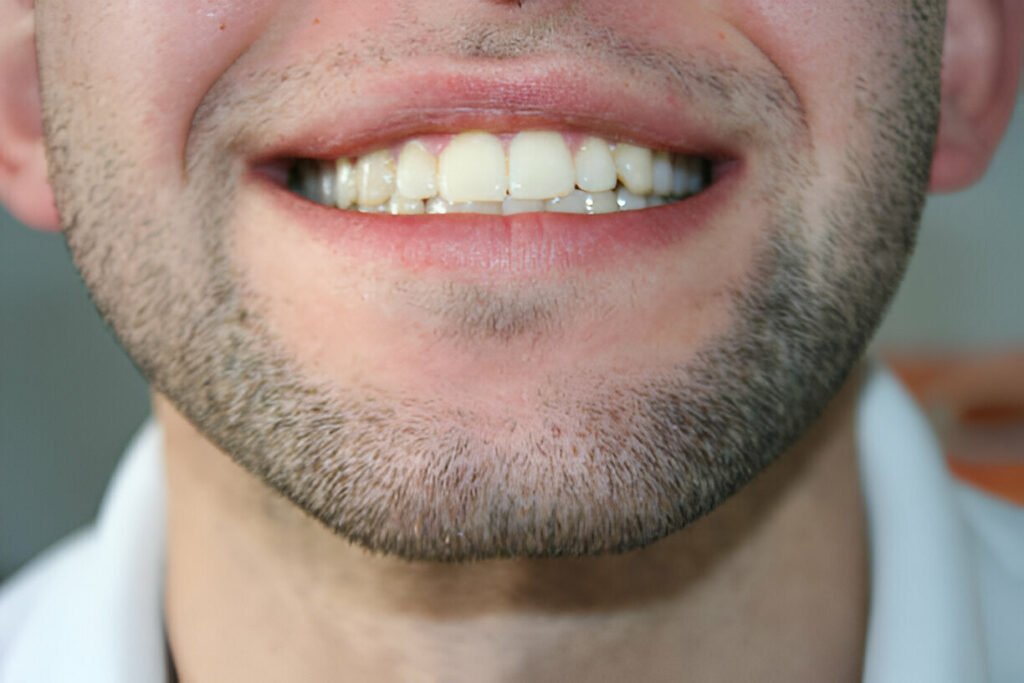Composite bonding is a popular dental treatment. It helps fix small cracks, chips, gaps, and stains on teeth. Dentists use a special tooth-coloured resin that sticks to the surface of the tooth. This makes the tooth look better and feel smoother. The resin is shaped to match the rest of your smile.
This treatment is quick and simple. Many people like it because it doesn’t cost too much and can often be done in just one visit. It’s also not painful, which is why more people are choosing it.
Do Dentists Grind Teeth Before Bonding?
In most cases, no. Dentists do not grind down your teeth like they do for crowns or veneers. But sometimes, they may gently roughen the tooth surface. This helps the bonding material stick better.
This step does not remove a large part of the tooth. It’s very light and only affects the top layer of enamel. So, your natural tooth stays safe and strong. The goal is to make sure the resin stays in place for a long time.
Why Do My Teeth Feel Weird After Composite Bonding?
Why Might Light Tooth Preparation Be Needed?
Every smile is different. In some cases, your dentist may suggest a small amount of shaping or smoothing. Here’s why:
- Better Fit: Light shaping helps the resin blend naturally with your tooth.
- Fix Uneven Edges: If a tooth is rough or pointy, small changes may help improve the final look.
- Stronger Bond: A rougher surface helps the resin grip better.
This preparation is always minimal. You won’t feel pain. In fact, you may not even need numbing.
Is Composite Bonding Reversible?
Yes, composite bonding is usually reversible. Since dentists do not grind your teeth much, your natural tooth structure stays almost the same. That means if you ever want to remove the bonding material, your tooth is still in good shape.
This is one of the reasons why people prefer bonding over veneers, which need more enamel removal.
How to Get Rid of Stains on Composite Bonding
How Does the Procedure Work?
The process is easy and can be done in one visit. Here’s what usually happens:
- Cleaning – Your tooth is cleaned to remove any plaque or dirt.
- Etching – A mild gel is placed to roughen the surface just a bit.
- Bonding – The resin is added to the tooth. It is shaped to match your smile.
- Curing – A special light is used to harden the resin.
- Polishing – The bonded tooth is smoothed and polished for a shiny finish.
You can eat and drink as normal after the visit. But it’s best to avoid very hard or sticky foods for a while.
Will It Damage My Teeth?
No, bonding does not damage your teeth. The top enamel may be lightly etched, but it won’t make the tooth weak. With good care, the bonding can last for several years. Just remember to brush, floss, and visit your dentist regularly.
Also, avoid habits like nail-biting or chewing on pens, as these can chip the resin.
Can You Eat Chips with Bonded Teeth?
Do Teeth Look Natural After Bonding?
Yes, they do. Dentists match the resin to your tooth colour. The material is shaped carefully to look like your natural tooth. Once it’s polished, it’s hard to tell the difference. This is why many people use bonding to fix small flaws without changing their whole smile.
Can Everyone Get Bonding?
Most people can. It’s best for those with small cosmetic issues. If you have large cavities or bite problems, your dentist might suggest another treatment. Bonding is also good for teens or people who want a quick fix before a big event.
It’s always best to ask your dentist to check your teeth and give advice based on your needs.
Can You Bite into an Apple with Composite Bonding?
How Long Does Bonding Last?
Composite bonding can last between 3 to 7 years. With good care, it might last even longer. Over time, the material may stain or wear down a little. But it can be touched up or replaced without much hassle.
Regular check-ups will help your dentist spot any problems early.
Final Thoughts
So, do dentists grind your teeth for bonding? Not really. They only roughen the surface a little to help the material stick. There is no heavy grinding like with veneers or crowns. The tooth stays mostly untouched, which makes bonding a safe and smart choice for a better smile.
It’s quick, affordable, and easy to maintain. Plus, the results look natural and feel smooth. If you want to fix small flaws in your teeth, bonding might be the perfect option.
Schedule your consultation today!
Book Your Consultation Today at Bridge St Aesthetic and Dental Implant Clinic
Thinking about improving your smile with composite bonding? At Bridge St Aesthetic and Dental Implant Clinic, our expert team provides safe, gentle, and effective bonding treatments tailored to your needs. We focus on preserving your natural teeth while giving you the smile you’ve always wanted.
Schedule your consultation today and let us help you take the first step towards a confident, radiant smile. Call us now or visit our clinic to get started!
How Long Does Composite Bonding Usually Last?
Frequently Asked Questions
1. Do dentists shave teeth for bonding?
No, they don’t shave the tooth down. They only roughen the surface slightly to help the resin stick better.
2. Is tooth grinding painful during bonding?
Not at all. The procedure is painless and often doesn’t need any numbing.
3. Can bonding be removed later?
Yes, it’s reversible. Since little to no enamel is removed, bonding can be taken off without harming your tooth.
4. Does bonding feel like a real tooth?
Yes, it feels smooth and natural. Once polished, the resin blends in with your teeth.
5. Can you eat normally after bonding?
Yes, but avoid very hard or sticky foods. These can chip the resin over time.





